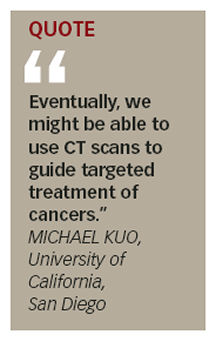Visualizing Cancer: Images of tumors can detect gene expression
- More than 2 years ago
Radiologists have found a way to use X-ray scans to identify which genes in a tumor are active.

The ability to glean genetic information about tumors from routine medical imagery could increase the use of cancer therapies that target a tumor’s genetic quirks. Targeted therapies promise better cancer treatments with fewer side effects than current approaches do. But doctors rarely profile a tumor’s genes, in part because it’s expensive to do and requires surgical removal of tissue.
“Genetic analysis of tumors is not usually done, but the first thing a doctor will do to a cancer patient is give them [an X-ray] scan,” says Michael Kuo of the University of California, San Diego, a coleader of the study. The new technique infers gene activity from such scans and so “lets us see gene expression of a tumor in a noninvasive way.”
The researchers looked at computerized tomography (CT) scans of liver tumors in 28 patients. CT scans use X rays to render virtual slices through a person’s body. Kuo and his colleagues identified 32 visible features—such as a dark halo or a region with mixed textures—that at least two radiologists could independently identify as present or not.
The scientists also measured the activity of 6,732 genes to create genetic profiles of the tumors. Comparisons of these profiles with the occurrence of the visual features revealed strong correlations between profiles and sets of features.
With this system, Kuo and his colleagues could use a CT scan to deduce the activity of more than 80 percent of the profiled genes in each tumor. To verify their system, the scientists tested a different set of 19 liver tumors and correctly gauged each tumor’s gene activity with an average accuracy of 74 percent. The research appears in the June Nature Biotechnology.
“Everyone is excited about this,” says Amy Hara of the Mayo Clinic College of Medicine in Scottsdale, Ariz. Tumors “all can look different, but we never really knew what that meant.”
Because scientists know the functions of many of these genes, Kuo and his team were able to link image features to tumor biology, which could guide diagnosis and treatment. For example, they found that three image traits were adequate to predict the activity of a gene called vascular endothelial growth factor (VEGF), which drives the formation of new blood vessels in growing tumors and is targeted by the cancer drug bevacizumab.
“Eventually, we might be able to use CT scans to guide targeted treatment of cancers,” Kuo says. “But that’s still a ways down the road.”
While the team used liver tumors for this research, the technique should apply to other kinds of solid tumors, such as those of lung and breast cancers, says Howard Chang of Stanford University, the other coleader of the study.
Although the study found correlations between the image traits and gene expression, it didn’t explain how particular genes cause the features seen in the images, Kuo notes.







